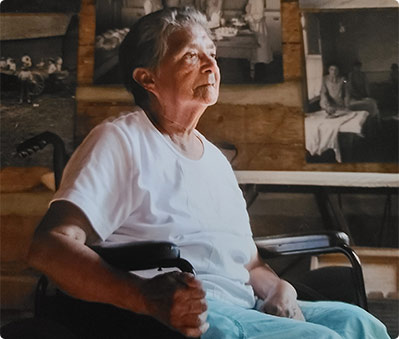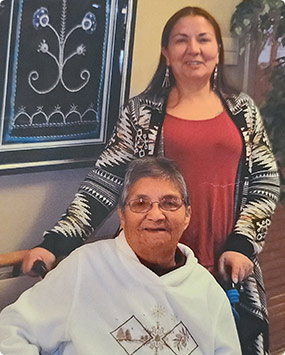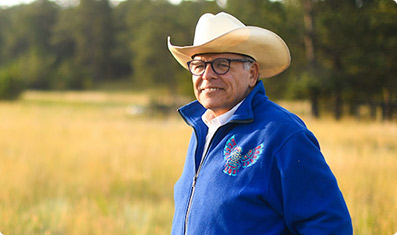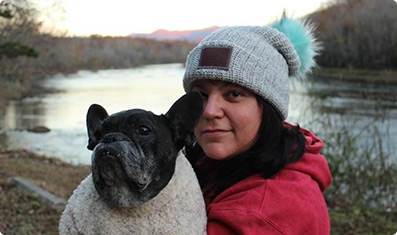
Fight Alzheimer’s Into 2025 and Beyond
Fight Alzheimer’s Into 2025 and Beyond
Don't miss your chance to make a generous gift to our 2025 Annual Fund Drive. Your donation today helps fund essential care and support to those who need it most, while also advancing critical Alzheimer's research.
Donate NowDementia presents unique challenges for Native peoples
 Alzheimer’s and dementia are an ever-growing threat to our entire nation — and nowhere is this demonstrated more clearly than within the American Indian and Alaska Native communities.
Alzheimer’s and dementia are an ever-growing threat to our entire nation — and nowhere is this demonstrated more clearly than within the American Indian and Alaska Native communities.For many years, the life expectancy of Native peoples was dramatically less than the rest of the U.S. population; now, it is only 5.5 years lower. With age as the greatest risk factor for developing Alzheimer’s, this increase in longevity has been accompanied by a growth in incidence of dementia that has left many tribes under-resourced and struggling to meet the needs of their members.
Some tribes do not even have a word for dementia. This comes as no surprise to Violet Blake. She moved from Milwaukee with her husband and children to the Oneida Reservation in Ashwaubenon, Wisconsin, to care for her mother, Shirley, who is living with mild cognitive impairment (MCI).

“Many members of our community still describe Alzheimer’s and dementia as something that happens to an elder when ‘their mind gets a fever,’” says Violet, who was largely unaware of the disease when she assumed the role of full-time caregiver. As she witnessed her mother’s slow, ongoing decline, she started to search for resources.
More resources needed
She found help by contacting the Wisconsin Alzheimer’s Disease Research Center, funded by the National Institute on Aging and the National Institutes of Health. They connected her to Oneida Nation Elder Services, a tribally operated program that provides home- and community-based services to the community’s elders. Elder Services partners with organizations like the Alzheimer’s Association to provide education and support — and most importantly, opportunities for respite care.“If I hadn’t reached out, I never would have known these programs existed,” Violet says. “And we would have never met Carol.”
Carol Bodga is an Elder Services coordinator who visited Violet and Shirley twice a week prior to the COVID-19 pandemic. “She taught me basic caregiving skills, like how to give Mom a shower, and concepts like ‘meet the person where they are’ rather than arguing with them about their reality,” says Violet. “She connected me with support groups and education, and found a program that Mom could go to every week so I could have a break.”
 Violet’s experience is not unusual, according to Spero M. Manson, Ph.D., distinguished professor of public health and psychiatry who directs the Centers for American Indian and Alaska Native Health. Manson identifies as a Pembina Chippewa.
Violet’s experience is not unusual, according to Spero M. Manson, Ph.D., distinguished professor of public health and psychiatry who directs the Centers for American Indian and Alaska Native Health. Manson identifies as a Pembina Chippewa.“There are many issues in the Native community that are shared with the population at large, such as the inability to recognize warning signs,” Manson says. “But that intersects with issues more specific to this population. The lack of caregiver resources is highly magnified in this community, which is largely impoverished. There are very few health services in general, and the sense of obligation and responsibility around caring for elders at home has consequences.”
Losing traditions
In American Indian and Alaska Native cultures, elders are valued as spiritual leaders, the wisdom keepers of traditions, educators and decision-makers. As more elders develop Alzheimer’s and dementia, they are less able to fill these roles. In addition, because there is stigma around placing elders in long-term care communities, the majority of elders are cared for at home by their families — which can place a strain on caregivers.“Elders are culturally and socially critical to who we are, as Native people in our respective communities, particularly to our youth and young adults,” says Manson. “So there’s an added burden that Native communities face."
One answer may lie in tribal nursing homes and long-term care communities, which are built on or near a reservation, and pay unique attention to cultural and social appropriateness, including traditional food, art, music and storytelling.
 Blythe Winchester, M.D., MPH, CMD, is an enrolled member of the Eastern Band of Cherokee Indians who practices as a geriatrician in her hometown of Cherokee, North Carolina. She is also the medical director of the tribal long-term care community there.
Blythe Winchester, M.D., MPH, CMD, is an enrolled member of the Eastern Band of Cherokee Indians who practices as a geriatrician in her hometown of Cherokee, North Carolina. She is also the medical director of the tribal long-term care community there.“In addition to those cultural elements that remind people of their home, you also tend to have a lot of community members working there as nursing staff and in other roles. That makes residents and their families just automatically feel better and more at home in that kind of environment,” Winchester says.
Winchester’s observation echoes new data released in the Alzheimer’s Association 2021 Alzheimer’s Disease Facts and Figures report. While 92% of Native Americans feel it is important for health care providers to understand a person’s ethnic or racial background, fewer than half feel they have access to providers who are culturally competent. Tribal nursing homes may be able to help address these concerns.
Raising awareness
Another way to increase awareness in tribal communities is by educating younger generations — and asking them to be spokespeople within their communities.After what she has learned caring for her mother, Violet sees it as her responsibility to share her knowledge with the rest of the tribe.
“On the reservations, there is a history of mistrust around taking help from the outside,” she says. “You’re more apt to take the message if it comes from yourself.”
Ultimately, collective efforts from multiple organizations, tribal communities, the government and research institutions may be the most effective path forward in addressing the growing prevalence of Alzheimer’s and dementia in Native communities.
In 2020, the Healthy Brain Initiative — a partnership between the Alzheimer’s Association and the Centers for Disease Control and Prevention — released the Healthy Brain Initiative Road Map for Indian Country. This plan is designed to encourage conversation among sovereign tribes about how they can address the disease.
Our commitment to diversity and inclusion
Diversity and inclusion are vital to the Alzheimer's Association mission. We lead a number of strategic initiatives to support diversity and a culture of inclusivity.
“It’s been hugely important because once you have information like that getting out, there’s more attention in terms of funding, policy and involvement from other groups,” Winchester says.
Despite the challenges and change, Violet has been able to find some bright spots, both as a caregiver and in life on the reservation close to family.
“My aunties come over all the time,” says Violet. “They talk about memories from long ago that they have never talked about in their whole lives, like how they used to work in orchards and potato fields. My mom remembers like it was yesterday. We sit back and listen to their old stories that we never knew.”
Read More ALZ Magazine Articles

The first survivor of Alzheimer's is out there, but we won't get there without you.
Donate Now
Learn how Alzheimer’s disease affects the brain.
Take the Brain Tour



